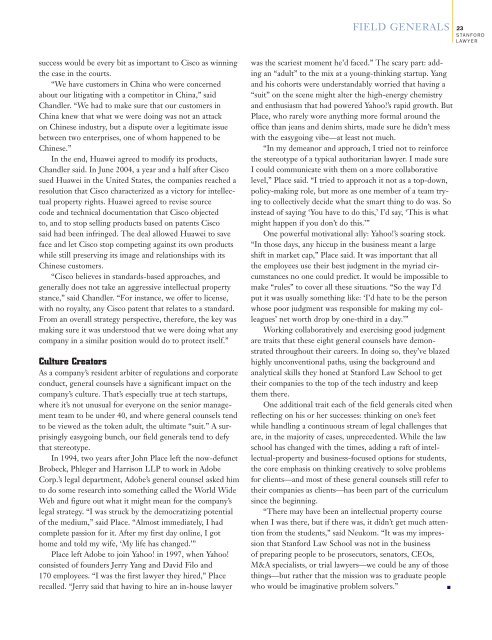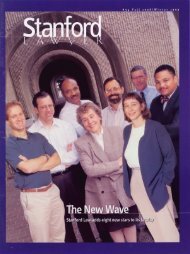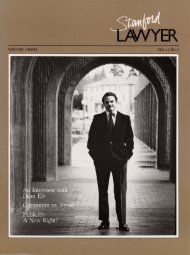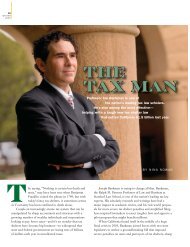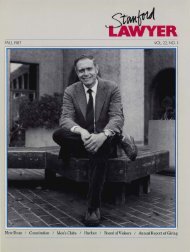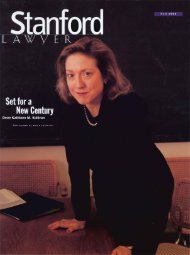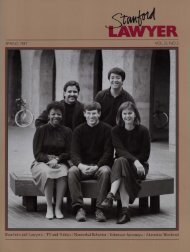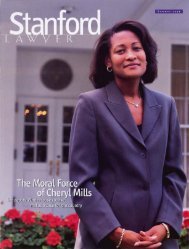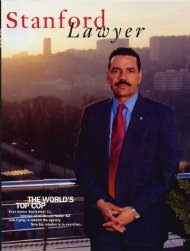Issue 73 - Stanford Lawyer - Stanford University
Issue 73 - Stanford Lawyer - Stanford University
Issue 73 - Stanford Lawyer - Stanford University
Create successful ePaper yourself
Turn your PDF publications into a flip-book with our unique Google optimized e-Paper software.
FIELD GENERALS<br />
23<br />
STANFORD<br />
LAWYER<br />
success would be every bit as important to Cisco as winning<br />
the case in the courts.<br />
“We have customers in China who were concerned<br />
about our litigating with a competitor in China,” said<br />
Chandler. “We had to make sure that our customers in<br />
China knew that what we were doing was not an attack<br />
on Chinese industry, but a dispute over a legitimate issue<br />
between two enterprises, one of whom happened to be<br />
Chinese.”<br />
In the end, Huawei agreed to modify its products,<br />
Chandler said. In June 2004, a year and a half after Cisco<br />
sued Huawei in the United States, the companies reached a<br />
resolution that Cisco characterized as a victory for intellectual<br />
property rights. Huawei agreed to revise source<br />
code and technical documentation that Cisco objected<br />
to, and to stop selling products based on patents Cisco<br />
said had been infringed. The deal allowed Huawei to save<br />
face and let Cisco stop competing against its own products<br />
while still preserving its image and relationships with its<br />
Chinese customers.<br />
“Cisco believes in standards-based approaches, and<br />
generally does not take an aggressive intellectual property<br />
stance,” said Chandler. “For instance, we offer to license,<br />
with no royalty, any Cisco patent that relates to a standard.<br />
From an overall strategy perspective, therefore, the key was<br />
making sure it was understood that we were doing what any<br />
company in a similar position would do to protect itself.”<br />
Culture Creators<br />
As a company’s resident arbiter of regulations and corporate<br />
conduct, general counsels have a significant impact on the<br />
company’s culture. That’s especially true at tech startups,<br />
where it’s not unusual for everyone on the senior management<br />
team to be under 40, and where general counsels tend<br />
to be viewed as the token adult, the ultimate “suit.” A surprisingly<br />
easygoing bunch, our field generals tend to defy<br />
that stereotype.<br />
In 1994, two years after John Place left the now-defunct<br />
Brobeck, Phleger and Harrison LLP to work in Adobe<br />
Corp.’s legal department, Adobe’s general counsel asked him<br />
to do some research into something called the World Wide<br />
Web and figure out what it might mean for the company’s<br />
legal strategy. “I was struck by the democratizing potential<br />
of the medium,” said Place. “Almost immediately, I had<br />
complete passion for it. After my first day online, I got<br />
home and told my wife, ‘My life has changed.’”<br />
Place left Adobe to join Yahoo! in 1997, when Yahoo!<br />
consisted of founders Jerry Yang and David Filo and<br />
170 employees. “I was the first lawyer they hired,” Place<br />
recalled. “Jerry said that having to hire an in-house lawyer<br />
was the scariest moment he’d faced.” The scary part: adding<br />
an “adult” to the mix at a young-thinking startup. Yang<br />
and his cohorts were understandably worried that having a<br />
“suit” on the scene might alter the high-energy chemistry<br />
and enthusiasm that had powered Yahoo!’s rapid growth. But<br />
Place, who rarely wore anything more formal around the<br />
office than jeans and denim shirts, made sure he didn’t mess<br />
with the easygoing vibe—at least not much.<br />
“In my demeanor and approach, I tried not to reinforce<br />
the stereotype of a typical authoritarian lawyer. I made sure<br />
I could communicate with them on a more collaborative<br />
level,” Place said. “I tried to approach it not as a top-down,<br />
policy-making role, but more as one member of a team trying<br />
to collectively decide what the smart thing to do was. So<br />
instead of saying ‘You have to do this,’ I’d say, ‘This is what<br />
might happen if you don’t do this.’”<br />
One powerful motivational ally: Yahoo!’s soaring stock.<br />
“In those days, any hiccup in the business meant a large<br />
shift in market cap,” Place said. It was important that all<br />
the employees use their best judgment in the myriad circumstances<br />
no one could predict. It would be impossible to<br />
make “rules” to cover all these situations. “So the way I’d<br />
put it was usually something like: ‘I’d hate to be the person<br />
whose poor judgment was responsible for making my colleagues’<br />
net worth drop by one-third in a day.’”<br />
Working collaboratively and exercising good judgment<br />
are traits that these eight general counsels have demonstrated<br />
throughout their careers. In doing so, they’ve blazed<br />
highly unconventional paths, using the background and<br />
analytical skills they honed at <strong>Stanford</strong> Law School to get<br />
their companies to the top of the tech industry and keep<br />
them there.<br />
One additional trait each of the field generals cited when<br />
reflecting on his or her successes: thinking on one’s feet<br />
while handling a continuous stream of legal challenges that<br />
are, in the majority of cases, unprecedented. While the law<br />
school has changed with the times, adding a raft of intellectual-property<br />
and business-focused options for students,<br />
the core emphasis on thinking creatively to solve problems<br />
for clients—and most of these general counsels still refer to<br />
their companies as clients—has been part of the curriculum<br />
since the beginning.<br />
“There may have been an intellectual property course<br />
when I was there, but if there was, it didn’t get much attention<br />
from the students,” said Neukom. “It was my impression<br />
that <strong>Stanford</strong> Law School was not in the business<br />
of preparing people to be prosecutors, senators, CEOs,<br />
M&A specialists, or trial lawyers—we could be any of those<br />
things—but rather that the mission was to graduate people<br />
who would be imaginative problem solvers.”<br />
■


